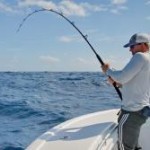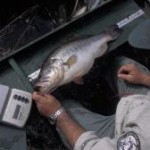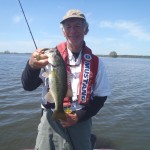Why should boat fishermen worry about ticks? I got Lyme Disease a few years ago and am almost positive I got it from three ticks I found on me after getting out of the boat at West Point Lake to answer a call of nature!
Human Illnesses Associated With Tick Bites
from The Fishing Wire
Anglers, hikers, anybody who spends time outdoors from now until the snow flies again might want to give this a careful read; ticks are found just about everywhere there’s good fishing, and they can cause some serious problems.
By Jeff L. Makemson, Certified Wildlife Biologist, Alabama Division of Wildlife and Freshwater Fisheries
As the weather warms and you are spending more time outdoors, don’t forget to allow time for a tick check. While some songwriters and comedians make light of ticks, a tick bite should be taken seriously. Ticks are the leading carriers of diseases to humans in the United States, second only to mosquitoes worldwide.
Ticks are small spider-like animals that bite to fasten themselves onto the skin and feed on blood. Ticks hide in low brush to allow them to come in contact with a host. Once they catch a ride on a host they will live in the fur and feathers of many different species of animals. Most tick bites occur during early spring to late summer in areas with many wild animals and birds. The toxins, secretions and organisms transmitted through a tick’s saliva are the sources of the tick-borne diseases. Most ticks do not carry diseases and most tick bites do not cause serious health problems.
It is very important to remove a tick as soon as it is found. This helps decrease the likelihood of contracting diseases from the tick. Care should be used to remove the tick’s head to prevent an infection in the skin where the bite occurred.
The sooner ticks are removed, the less likely they are to transmit disease. Use fine-tipped tweezers to properly remove an attached tick. Grab the tick as close to its mouth as possible. The body of the tick will often be above the skin’s surface, but its head and mouth will likely be buried. Grabbing the tick by its belly can force infected fluids out of its mouth and into the skin. Pull the tick straight out until its mouth lets go of the skin. Put the removed tick in a dry jar or Ziploc bag and save it in the freezer for later identification if symptoms start and medical attention is needed. Wash the area where the tick was attached with warm, soapy water once the tick is removed. Apply an antibiotic ointment to the bite area to help prevent infection.
Many tick-borne diseases cause flu-like symptoms, such as fever, headache, nausea, vomiting and muscle aches. Symptoms may begin from one to three weeks after the tick bite. Sometimes a rash or sore appears along with the flu-like symptoms. Common tick-borne diseases include Lyme disease, Rocky Mountain spotted fever, tularemia, ehrlichiosis, relapsing fever and babesiosis.
Lyme disease is an infection spread by the bite of ticks infected with the bacterium Borrelia burgdorferi. Symptoms include fatigue, headache, stiff neck, fever, muscle or joint pain, swelling, and sometimes an expanding red rash. If a rash develops, it may look like a target or bull’s-eye in some people. Lyme disease can be difficult to diagnose because its symptoms are similar to many other conditions and tests do not always detect the bacteria. It is usually effectively treated with a short course of antibiotics. If not treated properly, it can lead to complications involving the heart, nervous system, joints and skin within weeks, months or even years later.
Rocky Mountain spotted fever, also called tick fever, spotted fever, or tick typhus, is a bacterial infection passed to humans by wood ticks and dog ticks. It can lead to life-threatening complications such as shock and kidney failure if not treated promptly. Initial symptoms usually start an average of seven days after the tick bite and include a sudden fever, headache, muscle and joint aches, distinct rash, nausea and vomiting. The rash typically is made up of many tiny, flat, purple or red spots. It usually starts on the palms of the hands and soles of the feet, and then spreads to the arms, legs and the rest of the body.
Tularemia, also called deerfly fever or rabbit fever, is a disease that usually occurs in animals, but the disease can be transmitted to humans through an infected tick. Symptoms usually start within 21 days, but average one to 10 days, after the tick bite. Symptoms of tularemia include chills, sudden high fever, headache, an open crater-like sore at the site of the bite, swollen glands near the site of the bite, nausea and vomiting. Prescription medicine is used to treat tularemia.
Ehrlichiosis is an infectious disease that can be passed to humans by ticks. It causes fever, chills, headache, general ill feeling, nausea, vomiting and a purple or red rash. Symptoms usually start from one to 21 days (average of seven days) after the tick bite. Prescription medicine is used to treat ehrlichiosis.
Relapsing fever is an infectious disease that can be passed to humans by ticks. It is most common in the western United States. Symptoms usually start three to 11 days (average of six days) after the tick bite. They may last for several days, go away, and then return several days later. Symptoms include sudden high fever, headache, rapid heart rate, muscle aches, abdominal pain, general feeling of illness, and a rash in up to 50 percent of cases. Prescription medicine is used to treat relapsing fever.
Babesiosis is a rare parasitic disease that can be passed to humans by deer ticks. It may not always cause symptoms. When present, symptoms usually start one to four weeks after the tick bite. Symptoms of babesiosis include a general feeling of illness, decreased appetite, tiredness, fever, chills, recurring sweats and muscle aches. Babesiosis is treated with antibiotic medicines.
When returning home after spending time in areas where ticks may live, always carefully check for ticks on the skin and scalp. A little time spent conducting a tick check may prevent days, weeks or months of illness.
The Alabama Department of Conservation and Natural Resources promotes wise stewardship, management and enjoyment of Alabama’s natural resources through five divisions: Marine Police, Marine Resources, State Lands, State Parks, and Wildlife and Freshwater Fisheries. To learn more about ADCNR visit www.outdooralabama.com.


